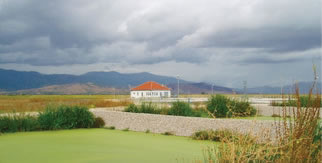
Management, Economics and Policy
Sustainable Water Resources Management Volume 2: Green Building Case Studies
Publication Date: January 2010
Cooperating Institution: Electric Power Research Institute (EPRI)
Principal Investigator: Bob Goldstein
Project Budget: $424,050
Project Identifier: DEC6SG06b
DESCRIPTION
This report evaluates how well green building rating systems address sustainable water management practices at the community level by applying three widely used rating systems to three diverse commercial green building projects. The case studies provide insight into the efficacy of green building water management practices and the relative strengths and limitations of rating systems with respect to achieving water sustainability at the community level. The intended audience for this report includes decision makers in the public and private sectors involved in community planning, building construction, energy management, and water resources management. The findings are relevant to architects, engineers, facility managers, owners, developers, and regulators.
This study examines three commercial building projects completed within the last ten years that showcase a number of innovative sustainable water management techniques. First, it investigates and documents the decision making process that led to the water management strategies implemented in each project, focusing on motives for and barriers to implementation. It examines unforeseen difficulties and surprises in the process of design and construction. The study goes beyond construction to evaluate how these buildings fare in operation and in what respects they perform differently than originally envisioned. Second, the study quantifies the environmental impact of water management technologies used at the study sites, linking the impact of green building practices to the watershed or community as a whole. Third, the study explores linkages among green building practices, green building ratings and standards, and the cumulative impact of these approaches on sustainable management of water. The study examines strengths and weakness of commonly used rating systems. Fourth, the study identifies barriers in local programs and codes to green building efforts and water resource sustainability. Finally the study identifies possible changes in green building rating systems and regulatory review processes for overcoming existing limitations.
Results include:
- Universal standards do not necessarily provide the greatest benefit for specific local/regional situations. Rating systems and regulators should consider the value of making ratings and regulations responsive to local factors.
- Very few aspects of current green building rating systems attempt to measure downstream or wider watershed impacts. Much of the focus is on water conservation and efficiency, with efficiency related to building plumbing fixtures—whether internal (toilets, sinks) or external (irrigation systems). There are rewards for site strategies that take into account permeability, infiltration, reuse, and evapotranspiration rates; but in general these factors are weighted equally with efficiency measures, even though they may be of greater benefit to the watershed and the environment as a whole.
- Consideration of single issues without regard for synergistic impacts is problematic. There is a need for inter- or multi-disciplinary judgments.
- Green building rating systems should consider incentivizing establishment of management frameworks to insure continuity between design and operations. Project teams should not end their involvement at the design and construction phases, but extend their involvement to operations.
As more communities and the nation as a whole drive to become sustainable and look to green building rating systems to incentivize water resource sustainability, it is important to carefully examine the strengths and limitations of these systems and to seek ways to improve them. It is important to consider how local conditions may override universal standards and best management practices, to take into account operational as well as construction requirements, and to bear in mind the relation between individual projects and the watershed and region. The electric sector needs to understand the perspective of the building sector and work to create and test new collaborative green building technologies and practices to achieve energy/water sustainability on the community and regional levels.

